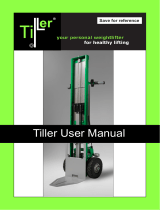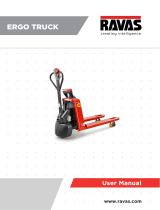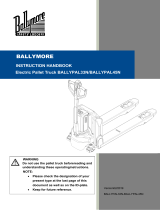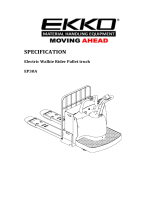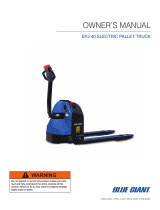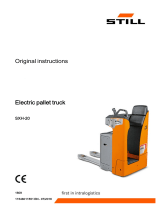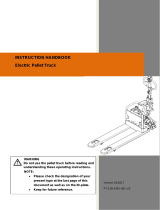11.14 EN
8
E Operation ................................................................................ 41
1 Safety Regulations for the Operation of the Forklift Truck....................... 41
2 Displays and Controls.............................................................................. 43
2.1 Battery discharge indicator ...................................................................... 45
2.2 Battery discharge monitor........................................................................ 45
3 Preparing the Truck for Operation ........................................................... 46
3.1 Checks and Operations to Be Performed Before Starting Daily Work .... 46
3.2 Preparing the truck for operation ............................................................. 47
3.3 Checks and operations to be carried out when the truck is operational .. 48
3.4 Parking the truck securely ....................................................................... 49
4 Industrial Truck Operation ....................................................................... 50
4.1 Safety regulations for truck operation...................................................... 50
4.2 Emergency Disconnect............................................................................ 52
4.3 Automatic braking.................................................................................... 54
4.4 Travel....................................................................................................... 55
4.5 Slow travel ............................................................................................... 57
4.6 Steering ................................................................................................... 58
4.7 Brakes ..................................................................................................... 58
4.8 Load handler raise/lower ......................................................................... 60
4.9 Lifting, transporting and depositing loads ................................................ 62
5 Troubleshooting....................................................................................... 66
5.1 Truck does not start................................................................................. 67
5.2 Load cannot be lifted ............................................................................... 68
6 Operating the truck without its own drive system .................................... 69
6.1 Release and activate the drive wheel brake............................................ 69
7 Optional equipment ................................................................................. 70
7.1 Emergency operation with service key GF60 .......................................... 70
7.2 Tiller with buttons on both faces .............................................................. 72
7.3 Keypad (CanCode) (o) ........................................................................... 73
7.4 Setting the truck parameters with CanCode............................................ 92
7.5 Parameters .............................................................................................. 94
7.6 Setting the Battery Parameters with CanCode........................................ 96
7.7 CanDis Display Instrument (o) ............................................................... 98
7.8 ISM access module (o)........................................................................... 99
F Industrial Truck Maintenance .................................................. 101
1 Operational Safety and Environmental Protection................................... 101
2 Maintenance Safety Regulations............................................................. 102
2.1 Working on the electrical system............................................................. 103
2.2 Consumables and used parts.................................................................. 103
2.3 Wheels..................................................................................................... 103
2.4 Hydraulic system ..................................................................................... 104
3 Lubricants and Lubrication Schedule ...................................................... 105
3.1 Handling consumables safely.................................................................. 105
3.2 Lubrication Schedule ............................................................................... 107
3.3 Consumables........................................................................................... 108
4 Maintenance and repairs ......................................................................... 109
4.1 Preparing the truck for maintenance and repairs .................................... 109
4.2 Lifting and jacking up the truck safely...................................................... 109
11.14 EN
8
E Operation ................................................................................ 41
1 Safety Regulations for the Operation of the Forklift Truck....................... 41
2 Displays and Controls.............................................................................. 43
2.1 Battery discharge indicator ...................................................................... 45
2.2 Battery discharge monitor........................................................................ 45
3 Preparing the Truck for Operation ........................................................... 46
3.1 Checks and Operations to Be Performed Before Starting Daily Work .... 46
3.2 Preparing the truck for operation ............................................................. 47
3.3 Checks and operations to be carried out when the truck is operational .. 48
3.4 Parking the truck securely ....................................................................... 49
4 Industrial Truck Operation ....................................................................... 50
4.1 Safety regulations for truck operation...................................................... 50
4.2 Emergency Disconnect............................................................................ 52
4.3 Automatic braking.................................................................................... 54
4.4 Travel....................................................................................................... 55
4.5 Slow travel ............................................................................................... 57
4.6 Steering ................................................................................................... 58
4.7 Brakes ..................................................................................................... 58
4.8 Load handler raise/lower ......................................................................... 60
4.9 Lifting, transporting and depositing loads ................................................ 62
5 Troubleshooting....................................................................................... 66
5.1 Truck does not start................................................................................. 67
5.2 Load cannot be lifted ............................................................................... 68
6 Operating the truck without its own drive system .................................... 69
6.1 Release and activate the drive wheel brake............................................ 69
7 Optional equipment ................................................................................. 70
7.1 Emergency operation with service key GF60 .......................................... 70
7.2 Tiller with buttons on both faces .............................................................. 72
7.3 Keypad (CanCode) (o) ........................................................................... 73
7.4 Setting the truck parameters with CanCode............................................ 92
7.5 Parameters .............................................................................................. 94
7.6 Setting the Battery Parameters with CanCode........................................ 96
7.7 CanDis Display Instrument (o) ............................................................... 98
7.8 ISM access module (o)........................................................................... 99
F Industrial Truck Maintenance .................................................. 101
1 Operational Safety and Environmental Protection................................... 101
2 Maintenance Safety Regulations............................................................. 102
2.1 Working on the electrical system............................................................. 103
2.2 Consumables and used parts.................................................................. 103
2.3 Wheels..................................................................................................... 103
2.4 Hydraulic system ..................................................................................... 104
3 Lubricants and Lubrication Schedule ...................................................... 105
3.1 Handling consumables safely.................................................................. 105
3.2 Lubrication Schedule ............................................................................... 107
3.3 Consumables........................................................................................... 108
4 Maintenance and repairs ......................................................................... 109
4.1 Preparing the truck for maintenance and repairs .................................... 109
4.2 Lifting and jacking up the truck safely...................................................... 109




















